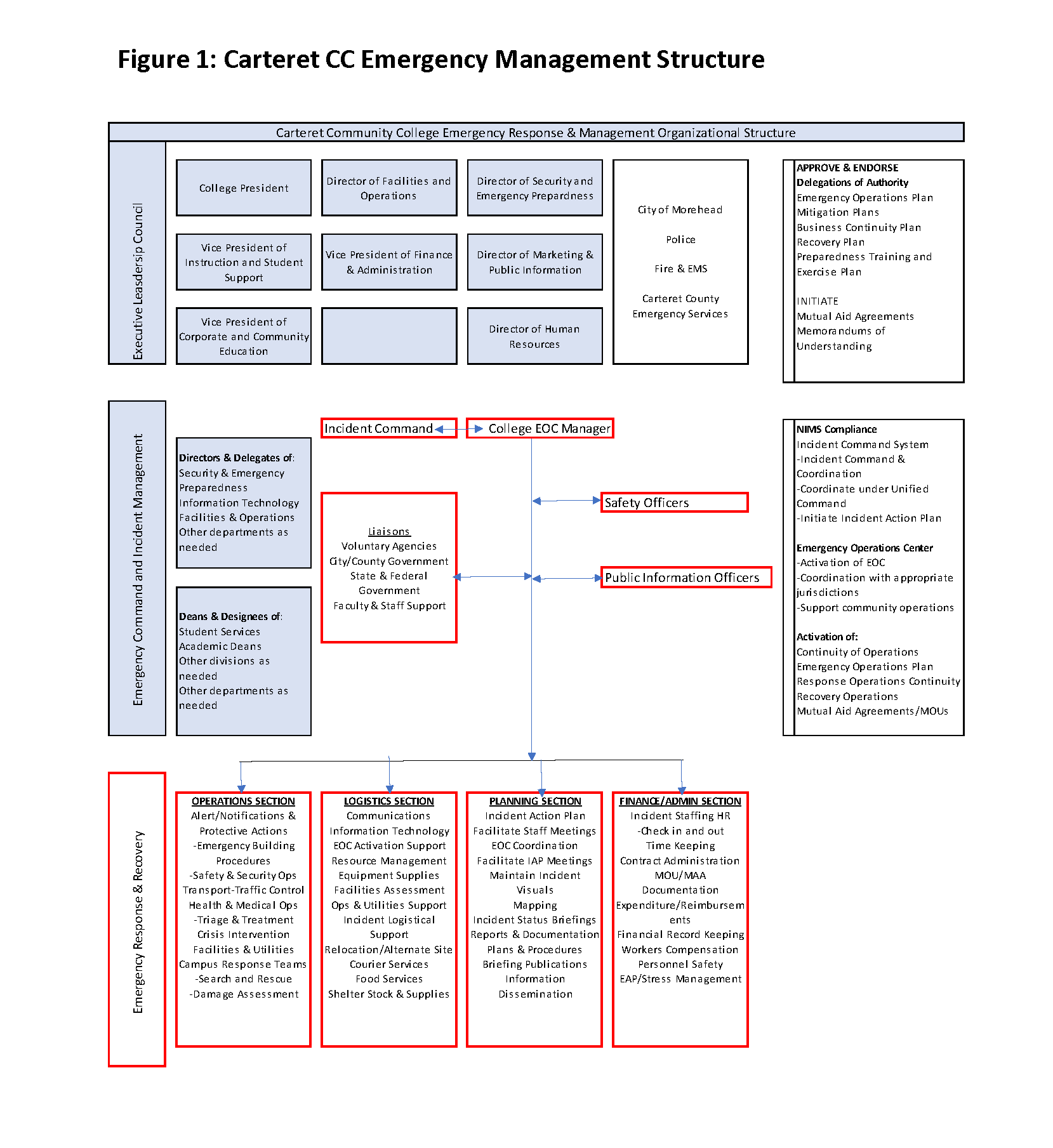Definition: The emergency situation may overwhelm the College or local authorities’ ability to manage within available resources and therefore must fully activate the EOC to address immediate response and long-term recovery planning. Damages are widespread and the College may need to be self-sufficient for several days. The College may request mutual assistance from local police agencies, local fire agencies, the City of Morehead, Carteret County Department of Emergency Management, The American Red Cross, and/or other agencies.
Actions:
- The Emergency Operations Plan and Center are fully activated. All normal college operations are suspended.
- Staff travel, vacations, and planned leaves may be terminated.
- The Emergency Operations Center coordinates efforts with Town of Morehead City Responders and Carteret County Emergency Management as needed.
- A plan to rotate Essential Personnel is established.
For a cohesive deployment of the EOP and functional aspects of emergency operations, personnel assigned to positions within Carteret Community College Emergency Management Structure shall be appropriately trained to perform assigned tasks. Training may be online or through in-person delivery from local, State, and Federal resources, as well as scenario-based exercises held on campus and with local partner organizations.
The following describes TIERS of response team members (illustrated in Figure 1) responsibilities:
|
College Board of Trustees |
On Standby for Emergency Meetings |
|
President and Executive Leadership Council: |
Delegation of Authority; MOU; MAA; Approval and endorsement of plans for Mitigation; Emergency Operations and other plans. |
|
Emergency Command & Incident Management: |
Direction, support and control of emergency operations through a virtual or functional EOC |
|
Emergency Response & Recovery Operations: |
Functional elements of incident and emergency response and recovery operations |

The Carteret Community College EOP is organized under the National Incident Management System (NIMS). Established by Homeland Security Presidential Directive- (HSPD-5) on March 1, 2004. HSPD-5 requires local jurisdictions, including higher education institutions, to implement NIMS in response to all-hazards that may affect their locality. Any updates to the Homeland Security Presidential Directives will be reviewed periodically for changes to this emergency operating plan.
The purpose of NIMS is to provide a common approach for managing incidents. NIMS uses a core set of concepts that are intended to be a flexible and standardized set of management practices. The Six Components of NIMS are:
- Command and Management (the Incident Command System);
- Preparedness (planning, training, and exercises);
- Resource Management (mobilize, track, and recover resources);
- Communications and Information Management (framework for all communications and information sharing);
- Supporting Technologies (voice and data communication systems);
- Ongoing Management and Maintenance (strategic direction and oversight for NIMS development).
Carteret CC EOC will be operated using the Incident Command System (ICS). Campus Personnel identified as “Essential Personnel” will be trained to document information for emergency responders. In the event of an incident, employees will notify emergency responders, provide first aid, and follow Incident Command instructions.
The primary objective of the Incident Command System is the management of assigned resources for effective control of any situation. The ICS organization expands and reduces in size and scope based upon the type and complexity of incident. Functions are delegated to the command and operational staff, who are trained and equipped to manage the "hands-on" details of the incident.
One of the most important best practices that has been incorporated into the NIMS is the Incident Command System (ICS), a standard, on-scene, all-hazards incident management system already in use by firefighters, hazardous materials teams, rescuers
and emergency medical teams. Carteret Community College has adopted these protocols for use in responding to and managing emergencies on campus. Further, the College commits to supporting this program with appropriate resources and training as required.
ICS is listed as the “Command and Management” concept of NIMS. It provides a standard organizational structure for incident management. The system is designed to be flexible in order to meet demands of particular emergencies. ICS allows incident managers to identify needs and concerns while managing resources that are necessary for responding to any incident.
The Incident Command System is structured to facilitate activities in five areas: command, operations, planning, logistics, and finance and administration. Analyzing the complexity of the incident allows for determination of which command structure areas are necessary to facilitate response.
Some factors that are necessary for determining complexity include impact to life, property, and economy; community and responder safety; weather and other environmental influences; likelihood of cascading events; area involved; and availability of resources. There are 14 essential features of ICS that are necessary in the successful management of any incident. These include:
- Common Terminology
- Establishment and Transfer of Command
- Chain of Command and Unity of Command
- Unified Command
- Management by Objectives
- Modular Organization
- Incident Action Planning
- Manageable Span of Control
- Incident Locations and Facilities
- Comprehensive Resource Management
- Integrated Communications
- Information and Intelligence Management
- Accountability
- Dispatch/Deployment
For further information on the essential features of ICS, including steps in effectively achieving the features, please visit see the Federal Emergency Management Agency's ICS training here.
